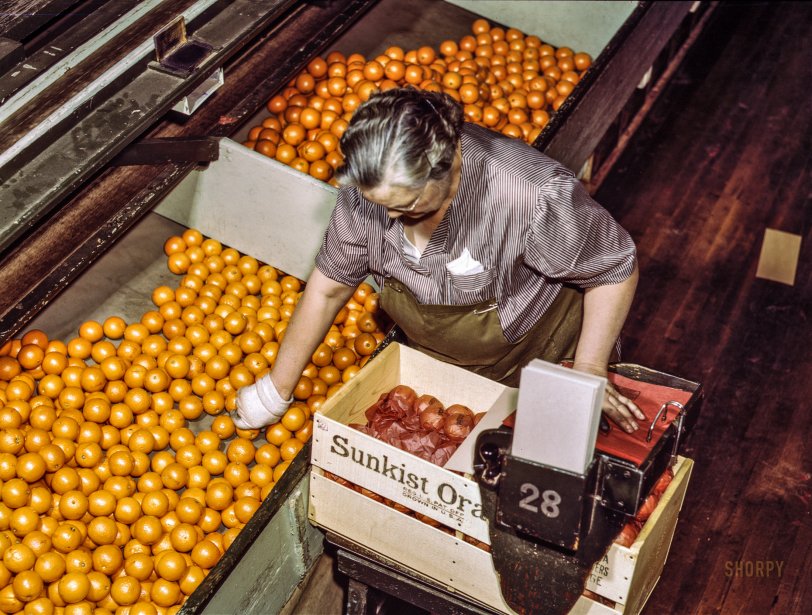


Framed or unframed, desk size to sofa size, printed by us in Arizona and Alabama since 2007. Explore now.
Shorpy is funded by you. Patreon contributors get an ad-free experience.
Learn more.

- Roll your own
- Rugged and real!
- A Charles Purcell - Mama Cass Connection
- Uncle SAAM
- Obfuscation
- One Chocolate Soldier rode away
- Victor Marquis de la Roche
- The Little House Across Way ...
- Vanderbilt Gates
- Vanderbilt Mansion
- You can still see that gate
- Withering heights for me
- So Jim,
- Top Heavy
- Re: Can't Place It.
- Bus ID
- Since you mention it
- The White Pages ?
- Moonlight Tower
- 1907?
- Fire(men) and Water
- Can't Place It
- Can anyone
- Wings
- Where's Claudette and Clark?
- Overbuilt Rolodex
- One song
- Give Me Wings Please!
- PRR
- Pinball Wizards
Printporium
The Industrial Orange: 1943

March 1943. "Santa Fe R.R. trip. Packing oranges at a co-op packing plant, Redlands, Calif." Kodachrome transparency by Jack Delano for the Office of War Information. View full size.
Repetitious but Welcome
Folks were happy to get those jobs then, it was hard but didn't last long--not long enough for many. You can see a finger cot on this lady's left index finger. She also had one on her thumb the better to pick up the treated sheets. My dad had a drugstore in Pomona and did a brisk trade in them during packing season.
Possibly this location.
This Sunkist building in Redlands has been repurposed, but at least it still exists.
it still said Sunkist on the side as recently as 20-ish years ago.
Wrapper stack
The spring-loaded device that is holding the papers down appears to be exactly the same as the one seen in the apple packing class a few posts back.
Time and Money
How many oranges in a crate, and long to pack it? I am curious if the packers were under pressure to meet a quota, and if there was accommodation for left-handed packers.
These oranges appear to be uniform in size, so I expect there was a standard number of them per crate.
I see she has one gloved hand to pick up the oranges and one ungloved hand to snag sheets of treated paper. She appears to be looking into the crate and not at the oranges or the paper. A process designed by efficiency experts?
Hand-wrapped
I've seen apples and pears individually wrapped. But for oranges, it wouldn't seem necessary unless that wrapping paper contains a spoilage or mold retardant. In any case, it looks like a boring, repetitious job for that worker!
The crate was as good as the oranges
There were many packing sheds along the Santa Fe and the then Southern Pacific lines in Southern California. Each orange was wrapped in treated paper to prevent the spread of mold, packed in strong wooden crates, loaded in cars which stopped at the ice plant and were on their way east. The crates were not re-used and provided endless uses for boys.
























On Shorpy:
Today’s Top 5